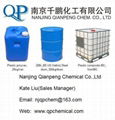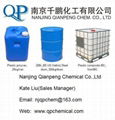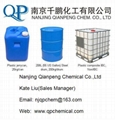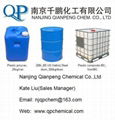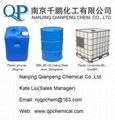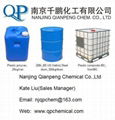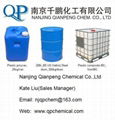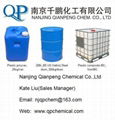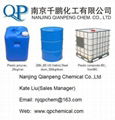| Model: | - |
|---|---|
| Brand: | - |
| Origin: | - |
| Category: | Chemicals / Chemical Auxiliary & Catalyst / Chemical Auxiliary |
| Label: | silane , 2768-02-7 |
| Price: |
-
|
| Min. Order: | - |
Product Description
Product No.: QP-027
The Equivalent Products to other Manufacturers:Wacker XL 10,Dow Corning Z-6300/OFS-6300,Shin-Etsu KBM-1003,Momentive A-171,Evonik VTMO,Chisso S-210
Chemical Name:Vinyltrimethoxysilane,(Trimethoxysilyl)ethylene; Ethenyltrimethoxysilan,Trimethoxy(vinyl)silane

CAS No.: 2768-02-7
INECSNo.: 220-449-8
Formula: C5H12O3Si
Appearance: Colorless transparent
liquid Density(ρ20, g/cm3): 0.9718 ± 0.0050
Refractive Index(n25D): 1.3925 ± 0.0050
Purity 98%
Applications and Performance:
Polymer Modification
QP-027 is used to modify polyethylene and other polymers by grafting its vinyl group to the polymer backbone
using a radical initiator, such as peroxide. This provides a polymer with pendant trimethoxysilyl groups that may
be used as moisture-activated crosslinking sites via hydrolysis of the alkoxy groups followed by condensation
of the resulting silanols.
Crosslinking of Silane-Grafted Polymers.
The reaction of Silane-grafted polyethylene to form a crosslinked or vulcanized polyethylene uses water to form
the crosslinks. This technology is widely used around the world for commercial applications in wire and cable
insulation, tubing, and other similar uses.
The basic reaction sequence is as follows: polyethylene is reacted (grafted) with vinyltrimethoxysilane, using a
peroxide initiator, in an extruder. The grafted polyethylene is then formed into a finished product, such as cable
jacketing, wire insulation, or pipe. The forming step is usually done by a second extrusion, during which a
catalyst for the moisture-cure step is added. Finally, the formed article is exposed to moisture or hot water to cause hydrolysis of the Silane and condensation to form crosslinks via Si-O-Si bond formation.
Benefits of Crosslinking
Higher maximum use temperature
Reduced deformation under load (creep)
Improved chemical resistance
Superior environmental stress crack resistance
Increased abrasion resistance
Improved impact strength
Memory characteristics (shrink film, tubing)
Improved impact strength
Advantages of Silane Crosslinking over Radiation or Peroxide Crosslinking
Low capital investment
Low operating (energy) costs
Higher productivity
Processing versatility
Thick, thin, or variable thicknesses possible
Complex shaps possible
Wilder processing latitude (control of premature crosslinking)
Useful with filled composites
Applicable to all polyethylene densities and copolymers.
Packing:
The regular packing of this product is 25kg plastic pail, 200L steel drums and 1000L immediate bulk container.
Storage and Shelf Life:
Should be stored in dry, cool, ventilated room; keep away from water, moisture, high temperature and fire. This product has a shelf life of at least 12 months if stored in tightly closed original container at room temperature.
If this product is kept beyond the shelf life recommend on the product label, it is not necessarily unusable, but a quality control should be performed on the properties relevant to the application.
Kate Liu(Sales Manager)
Nanjing Qianpeng Chemical Co.,Ltd
Email: njqpchem@163.com
Web: www.qpchemical.com
Member Information
| Nanjing Qianpeng Chemical Co.,Ltd | |
|---|---|
| Country/Region: | Jiang Su - China |
| Business Nature: | Manufacturer |
| Phone: | 13688459477 |
| Contact: | Kate Liu (Sales Manager) |
| Last Online: | 29 Jun, 2019 |

